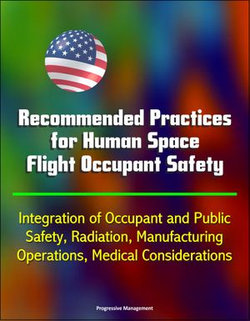The purpose of this document is to provide a compilation of practices that the Federal Aviation Administration (FAA) Office of Commercial Space Transportation (AST) believes are important and recommends for commercial human space flight occupant safety. The document is intended to enable a dialogue among, and perhaps consensus of, government, industry, and academia on practices that will support the continuous improvement of the safety of launch and reentry vehicles designed to carry humans.
The document can also be used to help identify subject areas that could benefit from industry consensus standards. There are a number of industry and government standards that address the subject areas covered in this document, but some subject areas may not have standards that are appropriate for the commercial human space flight industry. The development of industry consensus standards in these subject areas could have significant benefits for the safety of future commercial operations.
Lastly, the document may serve as a starting point for a future rulemaking project, should there be a need for such an effort at some point in the future. However, this document is not a regulation, and it has no regulatory effect.
The scope of this document includes suborbital and orbital launch and reentry vehicles. The document assumes that any orbital vehicle will stay in Earth orbit for a maximum of 2 weeks, and can return to Earth in under 24 hours if necessary. Orbital rendezvous and docking, flights longer than 2 weeks, extravehicular activity, and any flights beyond Earth orbit are not explicitly addressed. Future versions of this document may cover such additional human space flight operations and missions.
A. INTRODUCTION * 1.0 Purpose * 2.0 Scope * 3.0 Development Process * 4.0 Level of Risk and Level of Care * 4.1 Level of Risk * 4.2 Level of Care * 5.0 Structure and Nature of the Recommended Practices * 5.1 Categories * 5.2 Performance and Process Based Practices * 5.3 Depth and Breadth of Practices * 5.4 "System" vs. "Vehicle" * 6.0 Notable Omissions * 6.1 Medical Limits for Space Flight Participants * 6.2 Ionizing Radiation * 6.3 Integration of Occupant and Public Safety * 7.0 This Document's Relation to NASA Requirements * 8.0 Future Versions * B. RECOMMENDED PRACTICES * 1.0 DESIGN * 1.1 Human Needs and Accommodations * 1.2 Human Protection * 1.3 Flightworthiness * 1.4 Human/Vehicle Integration * 1.5 System Safety * 1.6 Design Documentation * 2.0 MANUFACTURING * 2.1 Manufacturing * 3.0 OPERATIONS * 3.1 Management * 3.2 System Safety * 3.3 Planning, Procedures, and Rules * 3.4 Medical Considerations * 3.5 Training * C. DEFINITIONS



Share This eBook: